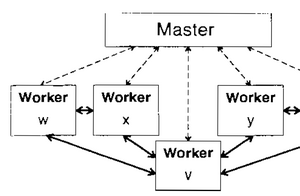CP - Parallel Simulation Techniques and Parallel & Distributed Simulation

Benchmark CP1 Parallel Simulation Techniques deals with parallel simulation techniques. Three test cases investigate effort and benefit of parallelization of time domain for continuous models.
The first case is a parallel parameter variation of the damping factor of the classical oscillation. The ODEs for the oscillation are not coupled, the ODE solver work independently in parallel. The second case study are five strongly coupled predator-prey models. Almost all of the ten ODEs are coupled with each other, so that any kind of parallelisation of the model shows a strong-ly coupled structure. The third case study requires only e weak coupling: discretizing the PDE for the swinging rope by the method of lines, results in weakly couples ODEs, where one line ODE is coupled only with the neighbouring lines. This weak coupling remains also if lines are grouped together. Tasks of this benchmark is the investigation of parallelisation variants for time domain analysis, qualitatively and quantitatively in comparison with the non-parallel simulation.
This benchmark has been set up in 1994, where the simulation community was experimenting with parallelisation, at times where parallel hardware was exotic, and software for parallelisation needed special knowledge. Nowadays simulation environments make use of the parallel hardware in modern PCs automatically, so that the primarily aims of the benchmark almost have lost relevance. But this benchmark is still a proper case study for introduction into the area, so it still has impact on educational level.
Benchmark CP2 Parallel & Distributed Simulation updates and extends the previous ARGESIM Benchmark CP1 Parallel Simulation Techniques. Three test cases, a Monte-Carlo study, a Lattice Boltzmann Simulation, and a PDE-based Simulation investigate effort and benefit of parallelization of time domain for continuous models.
The first test case is the Monte-Carlo for the damping parameter of a classical oscillation. The ODEs for the oscillation are not coupled, the ODE solver work independently in parallel. The second case study addresses the lattice Boltzmann method (LBM) for fluid flows, which is wide-spread in parallel simulation domains today. The method is derived from lattice gas cellular automata in which space, time, particle velocity and particle occupation state are all discrete. The case study is based on the famous cavity flow problem published by Hou et al in J. Comput. Phys. 118 (1995), where the behaviour of an incompressible fluid in a square enclosure, driven by a constant stream on the top boundary is examined. The task is to simulate the cavity flow with lattice size 257 x 257 for a number of 350.000 iterations – testing different parallelisation approaches for the flow dynamics. The third case study is based on the PDE for a swinging string with fixed length, fixed at both ends, excited at the beginning. Discretising the space equidistant and replacing the partial differential quotient by a central difference quotient, a set of weakly coupled ODEs replaces the PDE. Also, an analytical solution (approximation) can be calculated because of the line-arity of the discretized system. A classical separation approach can be used for calculating the solution (this yields with given initial and boundary conditions a solution with a Fourier series).
Nowadays simulation environments make use of the parallel hardware in modern PCs automatically, so that the primarily aims of the benchmark almost have lost relevance. But parts of this benchmark have an educational impact at modelling level, e.g. the different approaches for the swinging string PDE, and the introduction to Lattice-Boltzmann simulation.
